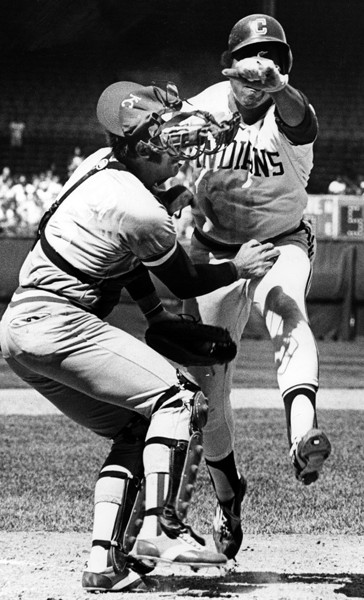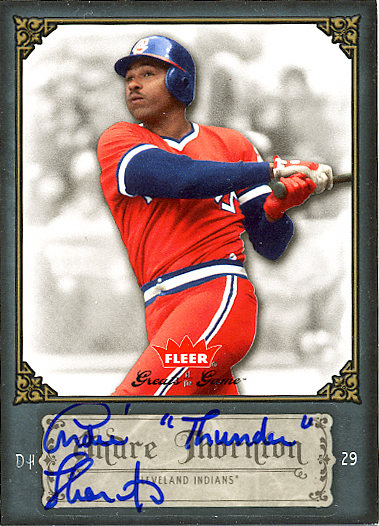 April, 1982. Indians outfielder Andre Thornton was making a comeback. He’d been the star of the team in the late 1970s - but by now, he was completing a nearly two-year rehab from multiple knee surgeries. On Opening Day of this new era, Thornton was inserted into the lineup as the designated hitter.
April, 1982. Indians outfielder Andre Thornton was making a comeback. He’d been the star of the team in the late 1970s - but by now, he was completing a nearly two-year rehab from multiple knee surgeries. On Opening Day of this new era, Thornton was inserted into the lineup as the designated hitter.
And Cleveland booed.
Not only was Thornton – nicknamed “Thunder” for his booming bat – one of the top American League hitters, he has possessed perhaps the highest level of personal character of any local sports figure. He received accolades such as the Roberto Clemente Award for humanitarian charity during his playing days; this was indicative of the role he welcomed in his private life. To this day, he devotes a great deal of effort as a Clevelander who makes a difference in his community, fund-raising to sustain his philanthropic interests. For years, he also has exhibited impressive entrepreneurial abilities.
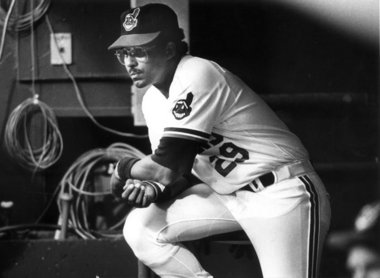 Thornton’s classiness is even reflected in his recollection of baseball memories. When asked to recall notable events from his career, he is liable to bring up other players’ achievements that he witnessed:
Thornton’s classiness is even reflected in his recollection of baseball memories. When asked to recall notable events from his career, he is liable to bring up other players’ achievements that he witnessed:
· Dennis Eckerley’s no-hitter, in 1977 against the California Angels.
· Len Barker’s perfect game, in 1981 vs. the Toronto Blue Jays.
· Mike Schmidt hitting four consecutive home runs, in 1976 while Thornton was with the Chicago Cubs.
Of course, there are fascinating anecdotes from Thunder Thornton’s career as well:
· He hit for the cycle against the Boston Red Sox in Fenway Park. The year was 1978, and the single, double, triple and home run each were hit off of a different pitcher (Allen Ripley, Tom Burgmeier, Bob Stanley and Jim Wright).
· Although he was never known as a fast runner, he hit two inside-the-park home runs- one in each league. The first one was in St. Louis while he was with the Cubs, against perhaps the speediest outfield in baseball (Lou Brock, Bake McBride, and Reggie Smith). It was a case of the ball bouncing high off the left field wall so sharply that the outfielders could not catch up to it in time. The second one was in Cleveland, in 1976. Chicago White Sox left fielder Richie Zisk tried to run down a Thornton drive off the wall, but had trouble negotiating the muddy turf.
You know of Duane Kuiper’s home run. I don’t need to tell you which one, because he only hit one during his entire career. It came in the bottom of the first inning against the White Sox’s (and Cleveland native’s) Steve Stone - two batters before Thornton’s inside-the-park homer.
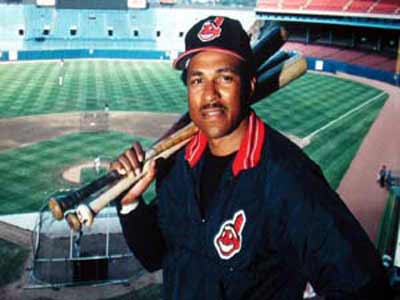 Thornton was originally signed as a teenager, by the Philadelphia Phillies. Included in the 1967 deal was the commitment on the part of the Phillies to pay for college, and to get him into the Pennsylvania National Guard (thereby avoiding the Viet Nam draft). He has talked of being invited to Connie Mack stadium and hitting home runs with an audience of his father, Phillies brass and manager Gene Mauch. Thornton was not a particularly hyped prospect, rather blossoming over time. He was traded to the Braves and then to the Cubs, where he showed serious promise in 1974 and 1975. He hit for power and displayed a good eye for the strike zone.
Thornton was originally signed as a teenager, by the Philadelphia Phillies. Included in the 1967 deal was the commitment on the part of the Phillies to pay for college, and to get him into the Pennsylvania National Guard (thereby avoiding the Viet Nam draft). He has talked of being invited to Connie Mack stadium and hitting home runs with an audience of his father, Phillies brass and manager Gene Mauch. Thornton was not a particularly hyped prospect, rather blossoming over time. He was traded to the Braves and then to the Cubs, where he showed serious promise in 1974 and 1975. He hit for power and displayed a good eye for the strike zone.
1976 saw his production tail off and he was traded to the Montreal Expos during the season. His poor start was a foreshadowing of what became a trademark trait for Thornton. He was a streaky hitter, and started most seasons with a slump.
This was also the case in 1977, his first year in Cleveland. Frank Robinson, a manager on borrowed time due to the Tribe’s losing ways, could not afford to be patient with Thornton. He soon benched the outfielder in favor of Bill Melton. But Thornton finished the year with a .263/28/70 line, along with 70 walks in 422 at-bats. The deal for Thornton (he was acquired for pitcher Jackie Brown, who’d come to the Indians with Mike Bibby in the Gaylord Perry trade in 1975 and was at the end of his career) has gone down as one of the best in Indians history.
Thornton had virtually no protection around him in the batting order in his years with the Indians. Notable hitters included Buddy Bell, Johnny Grubb and Gary Alexander- guys that could average 10 home runs apiece, with around 60 RBI and plenty of strikeouts.
Thornton attributed some of his success to weight training. He was ahead of his time in developing strength while retaining his quickness and agility. Observers noted his bat speed, and the arc of some of his towering, majestic home runs. And he was known for not really having a weakness in the strike zone. Some pitchers simply followed the adage, “if a batter is wearing glasses, pitch him low and away”. To varying degrees of success.
It is not truthful to say there was no talent on the Indians during Thornton’s time there. They had plenty of good pitching through the years: Eckersley, John Denny, Rick Sutcliffe, Bert Blyleven, and more. The problem was that during the 1970s, Tribe general managers often traded quality for quantity, filling roster holes and infusing the nearly-bankrupt franchise with cash. Majority owner Vernon Stouffer (1967 to 1972) had been identified by his general manager, Hank Peters, as being responsible for a dearth of players and scouts which would be felt for a generation. He apparently was right, as the franchise would wait until around 1990 to begin ramping up to World Series contention- under the returning Hank Peters, for a time.
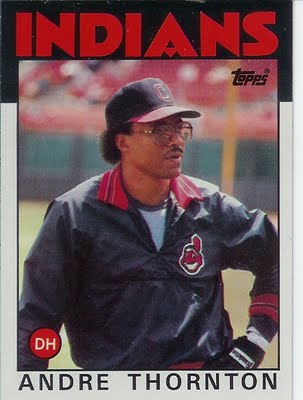 But Andre Thornton remained in Cleveland. He persevered through the knee problems, which the Tribe brass exacerbated. Duane Kuiper has stated (if you haven't lately, reread your “Curse of Colavito” book by Terry Pluto) that the Indians pressured Thornton into getting his knee surgery done quickly, without waiting to return to Cleveland and having it performed at the Cleveland Clinic. Kuiper said the team didn’t believe Thornton when he told them the knee still bothered him. Apparently, the first surgeon had inadvertently left a piece of damaged cartilage in the knee.
But Andre Thornton remained in Cleveland. He persevered through the knee problems, which the Tribe brass exacerbated. Duane Kuiper has stated (if you haven't lately, reread your “Curse of Colavito” book by Terry Pluto) that the Indians pressured Thornton into getting his knee surgery done quickly, without waiting to return to Cleveland and having it performed at the Cleveland Clinic. Kuiper said the team didn’t believe Thornton when he told them the knee still bothered him. Apparently, the first surgeon had inadvertently left a piece of damaged cartilage in the knee.
Thornton also stayed after becoming a free agent, at the end of the 1984 season. It was his second of two seasons as an All-Star, and he was looking to earn a salary roughly similar to the better designated hitters in the league. The Indians’ Gabe Paul (I’m sorry, I know he had success with the Yankees, but “Pope Paul” was another Tribe front office figure who bore a striking resemblance to a clueless buffoon) allowed Thornton’s contract to expire without submitting a counteroffer to Thornton’s three-year proposal. Conventional wisdom was that Thornton would walk. Peter Bavasi entered the picture as the new general manager, and took control of the impasse. He convinced the owner to offer Thornton a blank check. Bavasi trusted the player, and knew that if he made Thornton an offer, he would only be bidding up the salary along with the Baltimore Orioles and the Kansas City Royals. It worked, and Andre Thornton remained virtually the only source of interest in the team. These were the lean seasons leading up to A.L. commissioner Fay Vincent’s ultimatum to the city of Cleveland: build a new stadium, or risk losing the team.
On the seemingly natural fit of Andre Thornton in the Indians’ front office in retirement, that never happened. Those close to the team surmised that Thornton was smart enough to be perceived as a threat to those already in place. A presumed turf war mentality reigned. Thornton was owed some deferred salary, and he has said he offered his services to GM Dan O’Brien but that is as far as it went.
Both of Andre Thornton All-Star seasons were during his Indians years. From 1977 to 1987, he was the quiet foundation of the team, and his home run totals reached the 30s three times. He was a 2007 inductee into the Cleveland Indians Hall of Fame, along with Jim Bagby Sr., Mike Garcia and Charles Nagy.
The 1978 season was a particularly good one for Thornton- on the field. In October of 1977, he suffered the well-known tragedy of losing his wife and young daughter in a traffic accident during a sudden wind and snow storm. It occurred on the Pennsylvania Turnpike, near the town of Somerset (yeah, I think I can picture it, too). Manager Jeff Torborg, Buddy Bell, and Kuiper attended the funeral. Famously, Thornton has always ascribed his inner peace with his loss to his faith in the God he came to know years earlier, while with the National Guard.
He was, and remains, a Cleveland treasure, a rare sports figure who gives back to the city way more than he received. And he was booed! In 1982, local favorite Joe Charboneau was making a comeback (again), and fans wanted to see him installed as the DH. The Indians management kind of left Thornton twisting in the wind, basically casting the two players as rivals. Thornton has said that he is sure the Indians wanted Charboneau to take Thornton’s spot. But “Super Joe” faded and Andre Thornton’s career with the Tribe continued.
I swear, it seemed any sliver of good that happened with the Indians in those days was not simply the result of a happy accident. It occurred despite their best efforts to the contrary. And Andre Thornton's credentials as a local sports hero and a pillar of the community match up to anyone's- from a Herb Score, to a Doug Dieken, to a Bernie Kosar.
Thank you for reading. Next week: Blast From The Past: Pat Tabler.
Thornton, colliding with the Royals' Darrell Porter:
